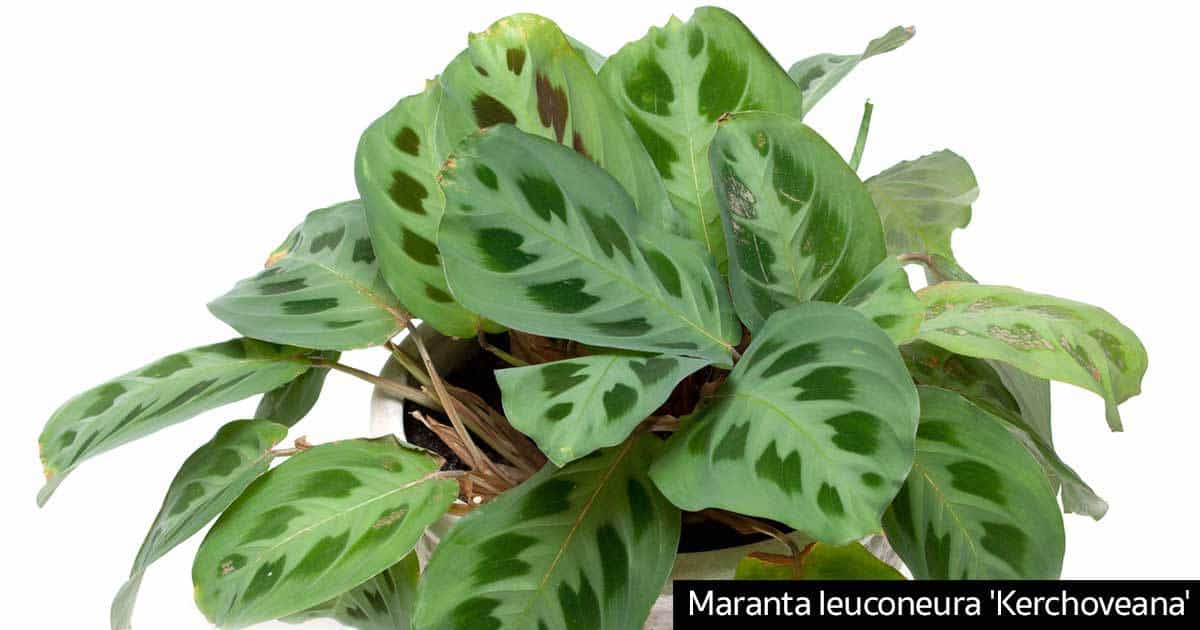Your cart is currently empty!
Prayer Plant Care – How To Grow Maranta Leuconeura
Maranta leuconeura is known as the “Prayer Plant.” The reason why?
Marantas fold their leaves into a huddle at night and go to “sleep.” The leaves fold upward like praying hands giving the plant its common name of prayer plant.
It is also often called the rabbit track plant because of the chocolate brown markings on the leaves of some varieties.
Maranta leuconeura ‘Kerchoveana’

Maranta leuconeura ‘Kerchoveana’ is undoubtedly the one most often seen of the Maranta species and related cousin the Calathea plant. Its light green leaves are somewhat rounded with inconspicuous veining.
There are dark splotches on either side of the main rib, and when the leaves are new, these splotches look dark brown sometimes, and in another light a deep green. This deep color fades as the leaf grows older.
One thing unusual about the leaf construction is that these two colors are not visible from the back, not even the vein arrangement. The color of the backs of the leaves is a silvery green with a close lined vein system, which makes the two sides of the leaf totally different.
The short section that connects the leaf and the stem is a deeper shade of green. It is here that the change in leaf position is made. This short section works like a hinge, spreading the leaf during the daytime and at night pulling it into a vertical position.
Some time ago I acquired a small plant of what was listed as Maranta tricolor. It has produced just one leaf in a year’s time, but it does have three colors, green, rose and white. The shape is much narrower than M. leuconeura, but the leaf has the same very sharp point, and the same hinged attachment to stem and leaf.
Maranta Discolor
Maranta discolor grows about a foot high, and its manner of growth is the same as the others. The leaves do not have that sudden extremely sharp point, but are long and narrow.
The full grown leaves are six to seven inches long, plain dark green with a very high sheen on top and deep purple undersides. They are thicker than the leaves of the other varieties.
Instead of changing the general direction of their leaves at night, they may droop some, but they fold lengthwise until the outside edges almost touch. While not as showy as the others because the colors are dark, there is a rich contrast that adds dignity to the group.

Growing Maranta
These marantas like a shaded location. A light north window suits them for the months spent indoors. They can be put outdoors during the summer in a place that is cool and shady.
Marantas rest at irregular intervals, but whenever that may be, they indicate their desire by the leaves browning at the ends.
Sometimes they die down to the ground, and even the roots dry up and look almost dead. It was at this stage I discarded my first plant, with thoughts of failure.
But if the pot is set aside and left almost dry, new growth will eventually start of its own accord.
Just where they are stored does not seem to be the important feature of the rest, for I have stored the pots in a warm, dry closet, and in unheated ones. Just put them where they do not freeze, and are kept dry.
New pink shoots will eventually grow. Some plants rest once a year, others may stay vigorous for two or three years.
If young leaves turn brown, the plants may be receiving too much hot sunlight. A stuffy, hot room with no moisture in the air will cause portions of house plant leaves to turn brown.
[embedded content]
Soil For Maranta
I use a loose soil composed of equal parts of sand, peat moss, shredded cow manure and good loam or leaf mold – again an African Violet mix will work fine.
The soil should be kept moist at all times unless the plant is resting. They receive a biweekly watering of liquid fertilizer which I’m sure I would not prepare for them alone, but because they are on the window sill with African violets, they receive the same treatment and they have shown their appreciation.
‘Kerchoveana,’ the commonly grown variety, is not as hardy as sansevierias, philodendrons, pothos, and other plants commonly grouped together and grown in indoor planters.
It will adjust fairly well to such a planting, and if the roots are not cramped, if the soil is rich and loose, and the air humid, the maranta will make an outstanding plant of interest for such a planting. Marantas occasionally have common white flowers.
by E McDonald
Share with Family and Friends
Featured Authors
Visit a Botanical Garden For Unique Experiences.
Comments
Logging in to comment gives you more features, but it is not required.
Subscribe
0 Comments
Oldest












